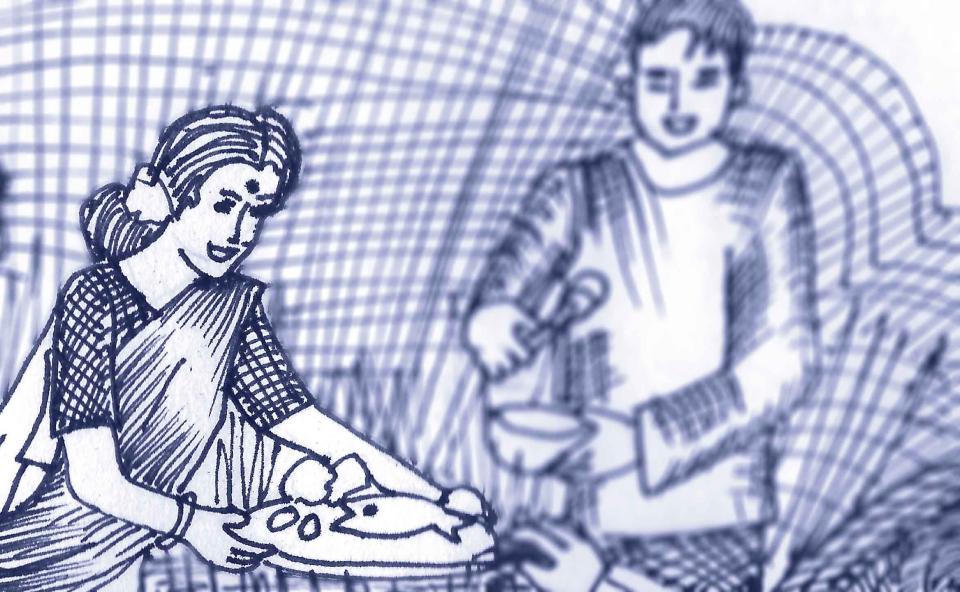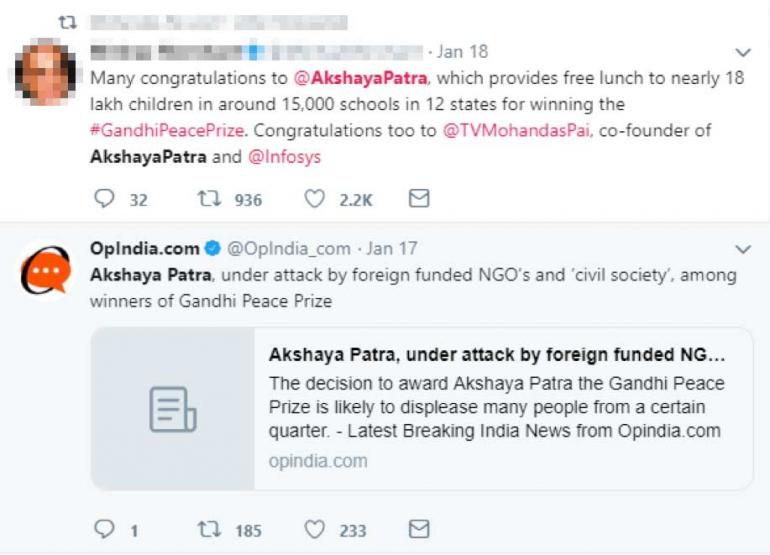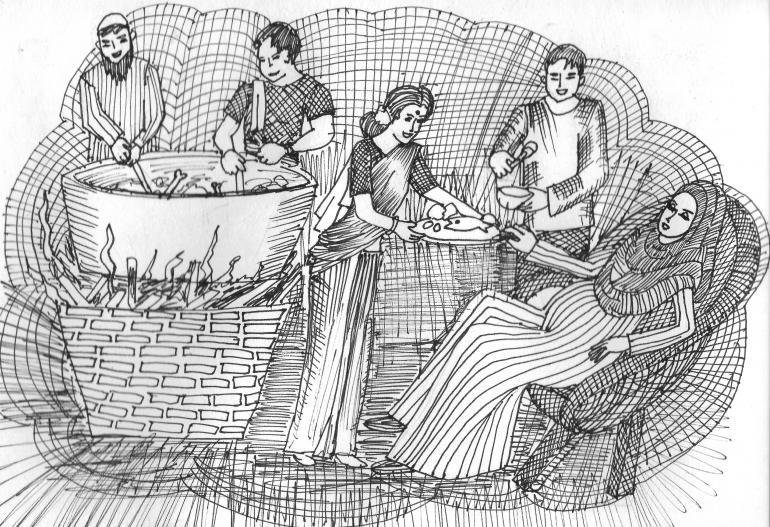
Image illustration: drawing of a woman in a sari serving a dish with fish on it. Illustrated by Dr. Sylvia Karpagam
Social media occasionally erupts into a tizzy over food choices. While true blue vegans swear by almond milk, non-dairy ice-cream, scrambled tofu, flaxseed, maple syrup, fortified plant milk etc., “pure’ vegetarians get into a sublime trance over thayir saadham , molagu maanga , poosanika pachadi, kurkure mushroom, malai chaap rolls, tandoori paneer momos, achaari tikkaDishes often described with relish that contain rice, curd, mango, cottage cheese, mushroom etc. etc. Meanwhile, the People for Ethical Treatment of Animals (PETA) are going ballistic over the extreme cruelty meted out on animals by the meat-eating, leather wearing, animal experimenting sections of society.
By a strange but not unnatural coincidence, caste and class sit closely aligned in each of these groups – with the ‘pure’ vegetarians lauding the vegan army, and also claiming to be PETA activists in their spare time. It’s also this same group that occupies large tractlands on social media with little cognizance or sensitivity on how little the other groups are represented in these spaces.
Discussions on social media around nutrition and food choice get cluttered with multiple issues. The modus operandi seems to be to shout, abuse, play the victim card and/or share links of google search documents that validate one’s own pet prejudices.
Discussions on social media around nutrition and food choice get cluttered with multiple issues.
In the meantime, India is reeling with several food-related crises. In some states, there are documented starvation deaths, especially with the introduction of the Aadhar card and biometric verification of people’s citizenship. Anaemia in women and children ranges from 50 -80%, almost all of it due to nutritional deficiency, and is the single largest cause of maternal deaths in the country. In the state of Karnataka alone, stunting (less height for age) is 39.1% and undernutrition (less weight for age) is 40.1% in children from the Scheduled Caste community – and this indicates a severe form of malnutrition ( -2 of the standard deviation from what is expected for this age). This along with deficiencies of most other vitamins, minerals and proteins make children extremely vulnerable to infections and high mortality rates.
As per the National Nutrition Monitoring Bureau data, 33.2% Indian men and 36% women have a Body Mass Index less than 18.5 which means they aren’t getting enough food to perform even activities of daily living, leave alone heavy labour. The poor in India have smaller heights, weights, chronic energy deficiency, poor bone health and a high risk of non-communicable diseases which can be attributed to poor diets that are cereal-heavy with nothing much else. For e.g. dietary calcium intakes in poor women is almost 700 mg less than the recommended daily allowance, leading to an increased risk of hip fractures and osteoporosis.
The poor in India have smaller heights, weights, chronic energy deficiency, poor bone health and a high risk of non-communicable diseases which can be attributed to poor diets that are cereal-heavy with nothing much else.
On average, Indian girls and boys are around 10 cm and 5-6 kg less than the expected heights and weights for their age. According to the National Family Health Survey (NFHS) 4th round, of the total children in India age 6-23 months, only 9.6% receive an adequate diet.
While food is an extremely personal choice, its access and availability are closely linked to and affected by policy decisions around the land, water, environment, agriculture, pesticides, labour rights, gender, caste, education, social welfare schemes, healthcare etc.
Let’s get some issues sorted first!

Image description: Screenshot of Twitter conversation on mid-may meal scheme and award. Source: author.
Which food is superior – animal or vegetable??
Humans require nutrients such as proteins, carbohydrates, vitamins, minerals, fats and oils. These are present in varying proportions in a wide range of foodstuffs, broadly classified as cereals, pulses, nuts and oilseeds, vegetables, flesh-based foods, fruits, milk and milk products. These nutrients ensure that brains, bones, muscles, eyes, heart, intestines, reproductive systems, hormones, skin, teeth, etc. are getting their optimal requirements.
Research shows that animal food, when eaten in the recommended quantity, has better absorption and bioavailability of proteins, vitamins and minerals than vegetable sources. Animal foods include birds, rats, pigs, cows, dogs, fish, snakes, eggs, milk and milk products, goats, poultry etc.
Research shows that animal food, when eaten in the recommended quantity, has better absorption and bioavailability of proteins, vitamins and minerals than vegetable sources.
The Indian Food Composition tables, 2017 by the National Institute of Nutrition shows that beef muscle and whole egg have higher protein bioavailability of 98% and 94%, respectively compared to vegetable proteins like Bengal gram (76%) and soya bean (54%). Meat is also an excellent source of vitamin B12, zinc, selenium, iron, niacin, and vitamin B6. The bioavailability of iron in pork muscle (86%) and beef liver (70%) is much higher than that of vegetables like spinach (19%) and lettuce (25%).
Eggs are a rich source of all nutrients except Vitamin C and its protein has high biological value and digestibility, so much so that egg is a reference protein in nutrition work. There are a large number of studies from India and the West which show that milk is essential for height increase during childhood and adolescence. Absence of milk in a child’s diet results in stunting. In turn, stunting is associated with diabetes and hypertension in adult life.
It may sometimes appear that feeding infants and preschoolers is rocket science requiring a great deal of innovation, funding and research. However, it is clear from guidelines that the best option is that children, by the age of one year, partake of the foods eaten in the household with the addition of milk, animal protein, nuts, oil or ghee, and coloured fruits and vegetables. In lieu of the smaller stomach capacity of children, there is a need for them to be fed 5-6 times in a day. If the government simply consulted a group of mothers and grandmothers, they would, given adequate resources, have more sensible and valuable options than corporates looking to make quick bucks.
It may sometimes appear that feeding infants and preschoolers is rocket science requiring a great deal of innovation, funding and research.
Different communities eat different types of animal products which may change as one goes up the social ladder. For e.g. some of the poorest communities that subsist on trapping and eating rats could opt to eat other sources like poultry, eggs, beef etc. if they moved up economically and socially. However, given the rigid hierarchical caste and class structures that operate overtly and covertly in India, this mobility is almost impossible. Those that do move up on the social ladder often continue to face harassment, discrimination, abuse, humiliation, rejection etc.
Nowhere is this more visible than in how the vegetarians treat the meat eaters. Ideas of purity/pollution, clean/unclean, higher value/base value, sattvik/tamassic play out repeatedly with the single-minded agenda of maintaining a hierarchical status quo of humiliating the meat eater into a self-imposed state of inferiority. It is important to understand that nowhere does ‘love of animals’ figure in this behaviour. That comes later, as an afterthought, when caste prejudice is challenged.
Ideas of purity/pollution, clean/unclean, higher value/base value, sattvik/tamassic play out repeatedly with the single-minded agenda of maintaining a hierarchical status quo of humiliating the meat eater into a self-imposed state of inferiority.
Food policies in India
Research, even when conducted by vegetarian academia, gives sharp and strong evidence in favour of animal foods. The biggest pitfall comes in their interpretation of and hesitation to disclose this evidence to people, a majority of whom are meat eaters. Instead, researchers have desperately tried to find ‘cheapest vegetarian alternatives’ to healthy foods. This is not even in their job description !! The language is one of erasure – "even though animal foods are superior, the government can give the following vegetarian foods"!!!
Research in the 40s and 50s involved looking for low-cost vegetable sources of proteins, such as soya, groundnut, pulses etc. that could be nutritional and "as useful as milk proteins". By 1955, it was well established that whatever the sources of vegetable proteins, when compared to milk protein in trials feeding sick or undernourished children, milk protein was far superior. The interpretation of this study however was that the "slight inferiority" of vegetable proteins should not obscure the fact that remarkable clinical improvement "almost as striking as with skim milk was noticeable".
One nutritionist acknowledges that bioavailability of Vitamin A from animal sources is better and then goes on to say that animal sources of Vitamin A being very expensive, those from vegetables “will continue to be the main source of vitamin A among poor communities for a long time to come” and recommends that “inclusion of about 40 gm of greens in the daily diets of such children can go a long way in ameliorating Vitamin A deficiency.”
At no point does she said that animal proteins should be made available and accessible – financially and socially to malnourished children. There seems to be a collusion to erase animal foods from people’s diets.
Elite vegetarian food includes liberal amounts of pulse, nuts, fruits, berries, vegetables and milk proteins from paneer, curd, cheese etc.. This is in no way comparable to the imposed vegetarianism being pushed down the throats of the poor, comprising primarily a cereal-based diet, with minimal amount of pulse and milk just sufficient for approximately two cups of tea.
This explains why the rich (including vegetarians) in India have been showing a consistent increase in heights, while the poor have not shown the same increase. In nutrition circles, it is believed that a population’s adult height may be used as a proxy for a nation’s development.
The language is one of erasure – "even though animal foods are superior, the government can give the following vegetarian foods"!!!
This cultural onslaught is at multiple levels. In India, the normal (and healthy) habit of eating beef has been converted into a crime deserving of state bans, lynching and murder. Vegetarian doctors advise patients to give up meat-eating in spite of no evidence in medical literature in support of this. College students are asked to switch to sattvik diets if they want to score well and become like the "meritorious". Children in schools are abused, harassed, insulted and humiliated by their peers and teachers for the foods they eat at home. Children who enjoy, and vastly benefit from, eating eggs, are systematically denied these in their school mid-day meals under the name of sattvik diet – which is a blatant religious imposition by a minority on the nutritional rights of children, even when it is legally mandated by the Supreme Court.
The social effect of this on children and young people is that they tend to distance themselves even from nutritionally superior foods that are traditionally eaten at homes and loss, over time, of cultural memory. Grandma’s tangy chutney or the flavourful dry fish that used to be a delicacy in one’s ancestral home could soon become just a memory that one may even be ashamed of.

Image description: Screenshot of Twitter conversation on mid-may meal scheme and award. Source:author.
With the current dismal state of nutrition in the country, rather than bringing the focus back to the importance of animal foods, the vegetarians in power are now scrambling to fortify cereals, feed ayurvedic preparations containing iron (loha bhashma), spirulina tablets, and load young adolescent girls with iron tablets. The rich and diverse traditional foods of different parts of the country are being transformed into one that depends on potions, tablets, additives and processing – all in an attempt to build on the myth of the vegetarian nation. Fortification takes away agency from communities to produce their own foods and places heavy dependence on companies, making foods less affordable and with an expiry date (thereby leading to unnecessary wastage).
Unethical politicians, with their vested interest of gaining votes and majoritarian support, necessarily create an enemy. In India, Dalits, Muslim, Christians become easy targets of hate built on a jumbled mess of half-truths, misinterpretations and falsehoods leading to the creation of fear that is completely disproportionate to the attributed crime. The enemy is not an action or an event, the enemy is an entire community, region, religion or caste group.
The enemy is not an action or an event, the enemy is an entire community, region, religion or caste group.
Corporates such as Pepsico, Nestle, Coca Cola, Mars, Ajinomoto, Unilever, Monsanto, Bill and Melinda Gates, World Bank etc, - never slow to identify a market opportunity, have already occupied the policy-making table in the country, along with the predominantly vegetarian policymakers to push for fortification, processed foods, veganism and sattvik diets. The vegans, in the meantime, have quietly snuck up into the Indian sub-continent riding on the backs of the processed food industry – an agenda of large corporates and multinationals to divest food from the hands of communities and take full control.
Which food would animals prefer for humans?
Well if one were to look at meat-eating from the animal’s point of view, then one would ban all forms of meat-eating. This argument however cannot be confused with whether animal food or plant food is nutritionally better for humans. Animal foods are still superior for humans.
Which food is better for the environment?
This question should actually be reworded to what kind of food production is good for the environment? Or rather, what is bad? What is bad is surely centralized, company driven, processed food grown on large tracts of land, laden with pesticides, without taking into consideration local community needs. Any food – vegetable or animal grown in this manner burdens the environment. Companies are disrespectful of the knowledge of traditional farmers and communities who are better able to understand the land. They may need support in modern methods or better methods, but they are important stakeholders. In the greedy quest for large scale production, companies violate all possible guidelines.
Conclusion
It is no rocket science to understand that a balanced diet is one that provides all the essential nutrients in proper proportions to meet the multiple physiological functions that the body performs such as digestion, circulation, excretion, temperature control etc.
Vegetarianism in India is projected as a marker of higher living, locating the non-meateater as having superlative status, a sattvik star so to speak. While it’s perfectly fine to eat what one wants, or not eat what one doesn’t want to, the vegetarian also wants to make sure that no one else eats animal foods. This is often the crux of the nutritional crisis in India. Vegetarianism then becomes a tool to uphold and reaffirm casteist practices of untouchability, pollution, impurity etc. While social media participates in this food frenzy, we should also be cognizant of how poor quality vegetarianism, and now veganism, imposed on the poor takes away their right to food and also leads to malnutrition and other consequences.
The subaltern communities on social media have come into their own. Many are savvy, articulate, and possessed with an irreverent sense of humour that goads and lambasts the supercilious, self-effacing self-righteousness of the vegetarians. Some meat-eaters tiptoe around the discourse, sometimes protesting and sometimes rebelling. Most others can’t participate as equals in social media discourses. They may get to watch videos of "people like them" getting lynched for eating foods of their choice, and may try to hide their food preferences in fear. Even doctors, nutritionists, right to food activists and public health professionals who challenge the "vegetarian model" are abused and called vile names on social media. They are accused of being products of a Christian/Western conspiracy, part of "international NGO nexus" or "Islamic terror groups" that want to destroy the culture of vegetarianism that they claim exists in India.
Even doctors, nutritionists, right to food activists and public health professionals who challenge the ‘vegetarian model’ are abused and called vile names on social media.
Children die in large numbers in India - not of rare, complicated illnesses but those that require a social cure. Children with wasted bodies and hollow faces without an ounce of body fat are ill prepared for even small illnesses that many well-nourished people sneeze through. Children die every day because they could not draw even on the smallest of resources to escape the inevitable stray bacteria or virus. Children also lose a primary and significant caregiver, particularly in the Indian context, when they lose a mother, who we often project as someone with a great deal of agency, who wilfully and willingly chose her own death over a life with her children. The denial of the role that society and governments play in these totally preventable deaths, is consistent and recurring. We constantly find reasons to believe that those on the fringes are there of their own choice.
For communities that struggle to eke out a daily living, existing on the brink of economic deprivation, the state becomes an important provider and protector of rights, dignity and also nutrition. Society has in it the power to influence this. Let us be mindful when we debate. Vegans from Western countries would also do well to understand that promoting India as a "model of veganism" further burdens and discriminates traditionally marginalised communities in India and makes them more vulnerable to physical, psychological and social abuse. Vegetarianism in India neither comes from a love for animals or humans. It only comes from a love of power and hierarchy.
Let us be mindful when we debate. Vegans from Western countries would also do well to understand that promoting India as a "model of veganism" further burdens and discriminates traditionally marginalised communities in India.

Image description: Drawing of various people cooking and serving food including meat and fish. Illustration by Dr. Sylvia Karpagam
- 22067 views






Add new comment